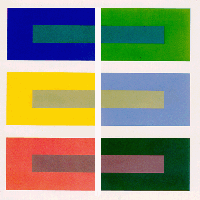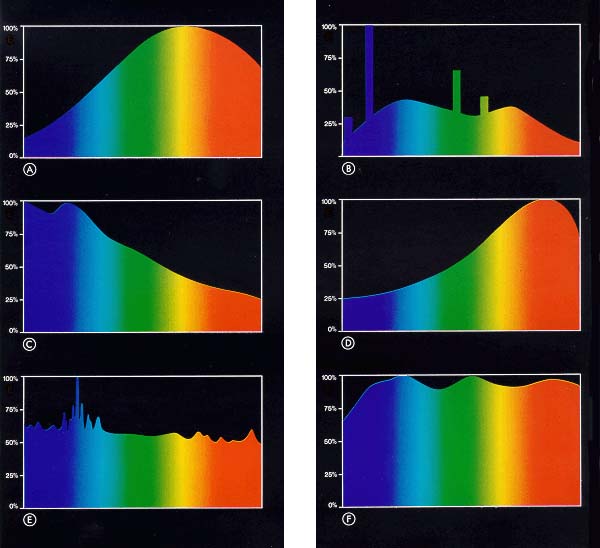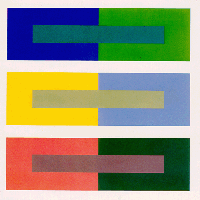The reality that the appearance of a color changes based on the colors surrounding it is called " Simultaneous Contrast ". Each one of the three horizontal center bars is of one single color only. Due to the surrounding colors that impression is changed. This can be easily verified by covering the vertical center line with a narrow piece of paper. It would be enough to hold a pencil or a pair of scissors in front of the screen covering the vertical center line.
When and Why Colors Change Their Appearance
Adaptation
The visual organ has adjusted itself to the conditions of light in the course of its biological development. It compensates the sometimes extremely different intensities of light through adaptation. For example, maximum intensity of light exists on the top of a 4000 m high mountain in bright sunlight at noon, or in a TV studio. In contrast, light intensity is minimal in an underground vault where only one candle is burning. These enormous differences can only be compensated through a logarithmic adaptation process. In both cases a good orientation is possible after an adaptation time. Twice the amount of light will then be perceived as an increase by one brightness degree. Equal to the diaphragm of a camera which closes if light intensity is high or opens if it is low the iris of the eye does likewise. Should in extreme circumstances this mechanical regulation of the iris not be sufficient a physiological sensitization change takes place.
Adaptation is the adjustment process of the visual organ to the intensity of light.
Conversion
Illuminations may have very differing spectral compositions, what is called radiation distribution. Long-wave rays are predominant in the evening when the flaming red sun stands on the horizon. Short-wave rays are predominant on an overcast summer day at noon. When light has different radiation distribution we are speaking of light types (illuminants). That is, the intensities of the wavelengths existing in the light can vary considerably. During daylight we find very different types of light according to weather situation and position of the sun. The same happens with artificial light. Light of a filament bulb sends out warm light, in other words light with predominantly long-wave radiation. In contrast, light from a neon tube can be cold light with predominantly short-wave radiation. Between the two extremes all imaginable intermediate stages are possible. Evidently, conversion of the visual organ is oriented towards an optimized recognition of color differences. It takes place through adaptation of the different photoreceptor cells on the retina to the radiation intensity of those spectral regions they are sensitive to.
Conversion is the adaptation process of the visual organ to the spectral composition of light, i.e. the "type of light"..
Simultaneous Contrast
Colors also change their appearance due to colors surrounding them. These are called Surrounding Colors. An artist painter does not really know what a color looks like from looking at it when it comes out of the tube or seeing it on his pallette. The appearance of a color only becomes apparent by influence of the surrounding colors once it is applied to the desired spot on the picture. The sensory mechanism of the visual organ provides a sort of Contrast Heightening with the purpose of sharpening color differences according to the sense impression, making them more recognizable. A consequence is e.g. that an artist painter must use two different colors if he wants them to look alike in different surroundings on the picture. On the other hand he may have to use the same color to have it look different with different surrounding colors.
Simultaneous contrast is the ability of the visual organ to change the appearance of color shades depending on the colors surrounding them.

Influence of Illumination
In the chapter Chain of Action between Light and Color Sensation we have learned that materials have the individual ability to reflect portions of incident light. Naturally, this can only be fully recognized if the rays which can be reflected by the particular material are present in the light. When viewing the violet-blue color under a warm, i.e. mainly long-wave light, then it looks black or blackened as this material is able to reflect short-wave light, however, the available illumination contains only a minimum amount of short-wave radiation. For this reason the violet-blue color cannot look violet-blue under the actual type of light as the non-existing short-wave radiation cannot be reflected. Based on this, matching light has been standardized, i.e. light to be used for checking and matching colors between a sample and its reproduction. The standardized types of light D50 and D65 are very important ! Type D 50 (5000 Kelvin) is equivalent to direct sunlight. Type D65 (6500 Kelvin) represents the medium daylight in central Europe. In a boutique hardly any person trusts the color a garment presents inside the shop when spotlighted by a halogen headlamp. One takes the garment to the window or outside to see the true color of it.
Spectral composition of the illuminant influences the appearance of colors.

Here we can see the spectral distribution of six different types of illuminants. In other words the varying intensities of wavelengths existing in the spectrum of the particular light. Picture (A) shows the spectrum of a filament bulb, (B) that of a fluorescent tube. (C) presents the spectrum of natural daylight as it can be in summer at noon and (D) when the sun is setting at the end of a fine day. The spectrum shown in picture (E) is that of a xenon lamp and (F) presents that of a standardized matching light, type D 50 which has a color temperature of 5000 Kelvin.

 Functioning Principle of Vision
Functioning Principle of Vision Color Mixing Laws
Color Mixing Laws Color and Printing Process
Color and Printing Process Theory of Color
Theory of Color Teaching Material and Literature
Teaching Material and Literature